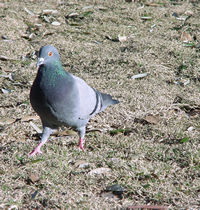|
Many people see pigeons as part of our natural wildlife and enjoy
seeing and feeding them. Part of their appeal is that they can become
very tame and will take food from your hand. Tens of thousands of people
keep pigeons as pets or to race. As a company we do not believe in
lethal control. The following information should not necessarily be taken as absolute
fact but more as general information.
A pair of adult pigeons can breed up to six times a year and will
usually lay two eggs each time. Disease: Pigeons carry a range of diseases such as salmonellosis, tuberculosis
and ornithosis. Whilst there is no direct evidence that the diseases
have been passed from pigeons to humans, the risk can not be discounted.
Because of their potential to contaminate food and spread disease their
presence in and around food premises can not be tolerated. Damage to buildings: Pigeon droppings are not only unsightly but can also cause long term
damage to buildings. Hazards: Pigeon dropping and waste food left down for pigeons make pavements
slippery, especially in wet weather. Startled pigeons may take flight suddenly and cause a hazard to road
traffic Feeding pigeons: Pigeons are wild birds capable of finding their own food. Human food does not contain the ingredients that the birds require for good health. Feeding pigeons attracts them to areas that are not natural to them and exposes them to risks of injury. This is why you often see pigeons with feet and wing injuries. Feeding results in all year breeding that causes overcrowding. The birds become stressed and disease and parasites spread quickly within the flock Large flocks of pigeons can drive smaller birds away from feeding sites. The pigeons can also spread disease to other birds, reducing their populations. Waste food left down for pigeons can attract foxes, rats and mice. RETURN TO TOP |


